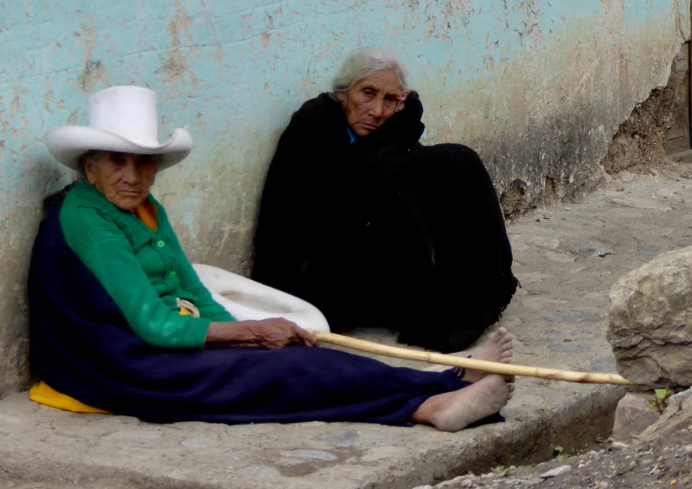
When a truck spilled mercury from a gold mine on the dirt road outside her house, Francisca Guarniz Imelda scooped it up with her bare hands, thinking it had healing powers.
She took it home to her mud-brick house in Choropampa, in Peru’s northern Cajamarca region. The heat of the day vaporised some of the mercury, contaminating the walls and ceiling with the toxic metal.
Twenty years later, Guarniz has difficulty walking, is losing her sight and suffers from kidney problems. She is not the only one to become ill or suffer after the spill. Farmers found no market for their crops, which buyers feared had been poisoned. Families moved away. Choropampa became like a ghost town.
Residents say they have received no assistance or compensation from the government.

In the past few months, more than five people have died from illnesses that locals believe are the result of the spill. Mayor Ronald Mendoza Guarniz says he feels his town is dying for a second time.
“We are burying our neighbours one by one,” he says. “The daunting question is who will be next.”
Disaster struck this community on 2 June 2000, when a canister of mercury overturned on a truck travelling to Lima, Peru’s capital, from the Yanacocha gold mine in Cajamarca, Peru’s poorest region. Yanacocha is Latin America’s largest gold mine.
More than 150kg of mercury – a byproduct of gold extraction – dribbled along the dirt road that passes through Choropampa and two other villages. Residents, including pregnant women and children, scooped up the liquid and took it home.
“We thought it was valuable. The silvery liquid was shining bright and the children immediately started collecting it,” Guarniz says. She filled a small bottle and placed it beside her bed, where she says it stood for five days before managers of the mine told the villagers that mercury was toxic.

An investigation into the spill by the World Bank’s International Finance Corporation (IFC) found that the canisters were not secured properly on to the truck and one had tipped over.
At the time of the spill, the IFC had a 5% stake in Minera Yanacocha, which is owned and run by the US-based Newmont Corporation, Peru’s Buenaventura Mining Company and Japan’s Sumitomo Metal Mining Co Ltd. The IFC sold its stake in 2017.
The mining company sent in a cleanup crew and offered villagers cash if they returned any mercury they had collected. However, according to an investigation by Defensoría del Pueblo, the Peruvian ombudsman’s office, only about a third of the mercury was recovered.
But by then it was too late. Some people had heated the mercury, hoping to extract gold from it. Others left it in open containers, where it vaporised at room temperature. Guarniz says they were unaware people could be poisoned by touching mercury or inhaling the vapour.
“Long-term exposure to mercury causes problems in the central nervous system, digestive system, renal system and immune system,” says Raúl Loayza Muro, a toxicologist at Cayetano Heredia Peruvian University in Lima. “The mercury which the people spilt in their houses has settled into minuscule holes and will continue to give off mercury vapours for many years.”
Mercury is especially dangerous for pregnant women, because it can cross the placenta and affect the foetus.
Seven days after the spill, residents including Guarniz were hospitalised for symptoms that included headaches, vomiting, red skin marks and bleeding from mouth and nose.

In total, 755 of the 3,000 inhabitants of the three villages affected by the spill were taken to hospital. Some had mercury levels in their urine five times the maximum limit recommended by the World Health Organization for non-occupational exposure.
One woman, Luisa Arribasplata Mestanza, became comatose and was transferred to a hospital in Lima. The last mayor Mendoza heard is that she was in a vegetative state.
Minera Yanacocha and the transportation company Ransa Comercial SA agreed to pay Arribasplata £78,000 and a monthly sum of £450 to cover health costs, as well as covering the cost of her daughter’s education, if they gave up their rights for any future redress. Defensoría del Pueblo said this was a violation of Arribasplata’s rights.
Minera Yanacocha and Ransa also agreed to pay villagers compensation in return for their silence, according to Defensoría del Pueblo. The contracts stated that the companies were not responsible for the spill and no legal action would be taken against them. Yanacocha also agreed to provide people with health insurance for illnesses related to the mercury spill. The majority of villagers signed. At the time, 87% were illiterate and signed using their fingerprints.

But in the two decades since the spill, health conditions have emerged that are not covered under the insurance scheme, leaving villagers unable to pay for treatment.
In a report in 2008, the Peruvian ministry of health said medical assistance for the villagers was “insufficient and must be improved”, and recommended further research into the extent of the contamination. But there have been no follow-up studies.
Mayor Mendoza’s wife, Alicia Errera Asañero, was 14 and on her way home from school when the spill happened. She collected some of the mercury. “I was in hospital for 15 days and given a lot of penicillin,” she says. She now suffers from bone problems, memory loss and has been diagnosed with immune thrombocytopenic purpura, a condition that causes the number of platelets in the blood to be reduced. Errera thinks it has been caused by the mercury she kept in her bedroom for five days, but there is no way to prove it.
“Our hands are tied, we can’t help them,” says Samuel Vigo Soriana, president of the council of mayors of Cajamarca. “Those contracts were a trap and I feel very sorry for them.”
Legal action against the mine is an option only for the 80 families who did not sign the contracts. “There are 36 legal cases [in Peru] still pending against Minera Yanacocha,” Roberto del Aguila, of Newmont, said in an email response to questions.
He added: “The medical care that this insurance has offered in recent times has no relation to possible effects or consequences related to the 2000 accident in Choropampa. We have treated common diseases such as the flu, diarrhoea, pregnancies, among others.”
One recent court case has been resolved in favour of the company, and the villager has appealed. In 2007, Newmont reached settlements with a small group of villagers who sued in the US courts.

Yanacocha said it had worked with the Peruvian authorities to address the impact of the spill. It said an environmental risk assessment carried out two years afterwards “show and confirm that once remediation efforts were performed in the affected areas, there was no contamination danger for the inhabitants or the environment in the areas where the accident took place”.
It added: “The company is aware that people’s health and environment protection is of utmost importance. This is why Yanacocha spared no effort or resource to solve the problems caused by the accident and to prevent something similar from happening in the future.”
The company said it allocated more than $15m (£12m) in monitoring programmes, medical care, mercury recovery, environmental remediation, and home cleanup, as well as in its individual and community compensation programme.
Lawyer and campaigner Mirtha Vásquez is working to find a more comprehensive way to aid people affected by heavy metal poisoning.
Vásquez, who in January was elected to the Peruvian national congress, said: “I’m submitting a proposal regarding laws about the treatment of people affected by heavy metals. Hopefully there will finally be a policy created that will help the victims.”
Vásquez has followed the events in Choropampa for many years and wants the companies to pay the villagers more compensation. “Over time people began to realise the damage … was not as simple as they were told, it was permanent damage,” she says.
For most villagers, though, hope has run out. Mayor Mendoza gazes across his dying town and sighs. “We are the forgotten ones,” he says.







